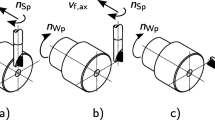Abstract
Aluminum metal matrix composites (Al-MMCs) are difficult to machine. The reinforcement of aluminum using ceramic particles accelerates tool wear. Moreover, demanded machining accuracies or properties of the surface layer are difficult to achieve. In the present study, the effect of silicon carbide reinforcement particles on the surface layer of the workpiece was investigated using multiple cutting conditions for dry turning. Three differently reinforced Al-MMCs regarding the volume percentage (17% and 30%) and the particle size (0.6 µm and 3 µm) and their non-reinforced matrix were considered as the workpiece materials. The reinforcement and the cutting condition affect the results of turning. A greater particle volume percent improves the surface roughness and decreases the tensile stress in the surface. The smaller particle size caused a lower tensile stress in the surface. A general effect of the particle size on the workpiece roughness can not be concluded. The most important cutting parameter for the surface layer of the workpiece is the feed. Greater feeds decrease the tensile stress in the surface, but deteriorate the surface quality.

















Similar content being viewed by others
References
Bian R, He N, Li L et al (2014) Precision milling of high volume fraction SiCp/Al composites with monocrystalline diamond end mill. Int J Adv Manuf Technol 71(1–4):411–419
Tomac N, Tonnessen K (1992) Machinability of particulate aluminium matrix composites. CIRP Ann Manuf Technol 42(1):55–58
Wang T, Xie L, Wang X et al (2015) PCD tool performance in high-speed milling of high volume fraction SiCp/Al composites. Int J Adv Manuf Technol 78(9):1445–1453
Pramanik A, Zhang LC, Arsecularatne JA (2008) Machining of metal matrix composites: effect of ceramic particles on residual stress, surface roughness and chip formation. Int J Mach Tool Manuf 48(15):1613–1625
Aurich JC, Zimmermann M, Schindler S et al (2016) Effect of the cutting condition and the reinforcement phase on the thermal load of the workpiece when dry turning aluminum metal matrix composites. Int J Adv Manuf Technol 82(5):1317–1334
Yang Y, Wu Q, Zhan Z et al (2015) An experimental study on milling of high-volume fraction SiCp/Al composites with PCD tools of different grain size. Int J Adv Manuf Technol 79(9):1699–1705
El-Gallab M, Sklad M (1998) Machining of Al/SiC particulate metal-matrix composites Part I: tool performance. J Mater Process Technol 83(1–3):151–158
Shahzad MA (2010) Analysis of the machinability of an aluminum matrix composite material. Dissertation, University of Kaiserslautern
Wang T, Xie L, Wang X (2015) Simulation study on defect formation mechanism of the machined surface in milling of high volume fraction SiCp/Al composite. Int J Adv Manuf Technol 79(5):1185–1194
Ge YF, Xu JH, Yang H et al (2008) Workpiece surface quality when ultra-precision turning of SiCp/Al composites. J Mater Process Technol 203(1–3):166–175
El-Gallab M, Sklad M (1998) Machining of Al/SiC particulate metal matrix composites. Part II: workpiece surface integrity. J Mater Process Technol 83(1–3):277–285
Cheung CF, Chan KC, To S et al (2002) Effect of reinforcement in ultra-precision machining of Al6061/SiC metal matrix composites. Scripta Mater 47(2):77–82
Kilickap E, Cakir O, Aksoy M et al (2005) Study of tool wear and surface roughness in machining of homogenized SiCp reinforced aluminium metal matrix composite. J Mater Process Technol 164–165:862–867
Teti R (2002) Machining of composite materials. CIRP Ann Manuf Technol 51(2):611–634
Dabade UA, Joshi SS, Balasubramaniam R et al (2007) Surface finish and integrity of machined surfaces on Al/SiCp composites. J Mater Process Technol 192–193:166–174
Quan Y, Ye B (2003) The effect of machining on the surface properties of SiC/Al composites. J Mater Process Technol 138(1–3):464–467
Schindler S, Zimmermann M, Aurich JC et al (2014) Thermo-elastic deformations of the workpiece when dry turning aluminum alloys-a finite element model to predict thermal effects in the workpiece. CIRP J Manuf Sci Technol 7(3):233–245
Sikder S, Kishawy HA (2012) Analytical model for force prediction when machining metal matrix composite. Int J Mech Sci 59(1):95–103
Dabade UA, Dapkekar D, Joshi SS (2009) Modeling of chip-tool interface friction to predict cutting forces in machining of Al/SiCp composites. Intern J Mach Tool Manuf 49(9):690–700
Klocke F, König W (2008) Fertigungsverfahren, Drehen, Fräsen, Bohren. Springer, Berlin
Karthikeyan R, Ganesan G, Nagarazan RS et al (2001) A critical study on machining of Al/SiC composites. Mater Manuf Process 16(1):47–60
Nakayama K, Arai M, Kanda T (1988) Machining characteristics of hard materials. CIRP Ann Manuf Technol 37(1):89–92
Schulze V, Zanger F, Michna J et al (2011) Investigation of the machining behavior of metal matrix composites (MMC) using chip formation simulation. Adv Mat Res 223:20–29
Denkena B, Biermann D (2014) Cutting edge geometries. CIRP Ann Manuf Technol 63(2):631–653
Biermann D (1995) Untersuchungen zum Drehen von Aluminiummatrix-Verbundwerkstoffen. Dissertation, University of Dortmund
Capello E (2005) Residual stresses in turning Part I: influence of the process parameters. J Mater Process Technol 160(2):221–228
Breidenstein B (2011) Oberflächen und Randzonen hoch belasteter Bauteile. Dissertation, University of Hannover, Habilitation
Acknowledgments
The authors would like to thank the German research foundation (DFG) for funding the project “Thermal effects when turning Al-MMC-experiments and simulations AU 185/26, STE 544/42” within the priority program SPP 1480 and the state research focus advanced materials engineering (AME) at the University of Kaiserslautern.
Author information
Authors and Affiliations
Corresponding author
Rights and permissions
About this article
Cite this article
Aurich, J.C., Zimmermann, M., Schindler, S. et al. Turning of aluminum metal matrix composites: influence of the reinforcement and the cutting condition on the surface layer of the workpiece. Adv. Manuf. 4, 225–236 (2016). https://doi.org/10.1007/s40436-016-0152-7
Received:
Accepted:
Published:
Issue Date:
DOI: https://doi.org/10.1007/s40436-016-0152-7




